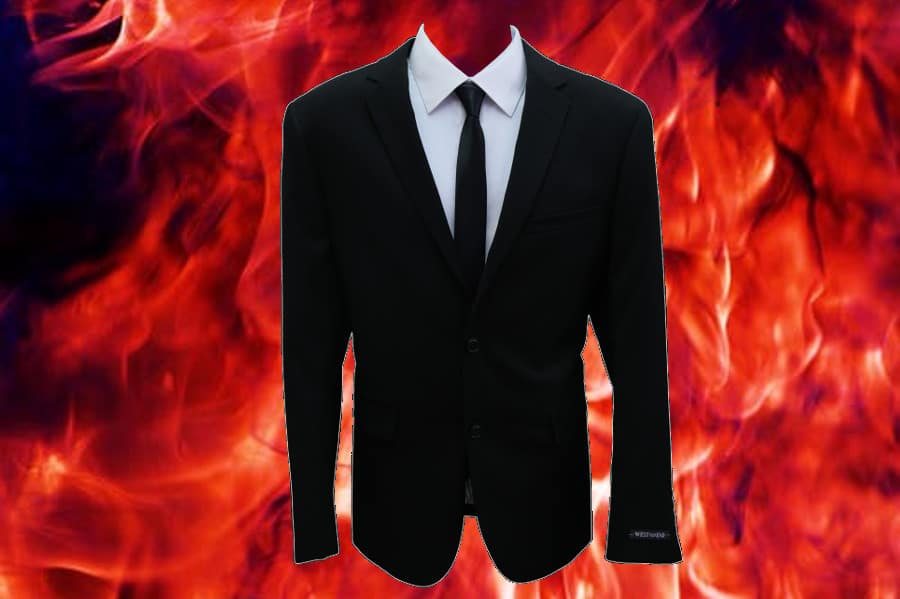The decision to cremate or to bury is not an easy decision to come to. Assuming that you have elected with cremation, there is the further consideration as to what the deceased will wear.
Can the deceased be cremated with their favorite T-Shirt? Can they be cremated in their best suit? How about some sentimental keepsake. Is clothing even worn during the cremation process?
Clothing is usually worn during cremation, but it is optional. Furthermore, the type of clothing is also optional. Due to laws differing in each state, you will certainly need to consult your funeral director or the crematorium to verify if certain items are or are not permitted.
Below I’ve gathered together everything you need to know about choosing the right clothing for your loved one’s cremation, some of the information may even surprise you!

Different options for cremation
First of all, we must define the types of cremation. There are currently two types of cremation; flame-based and water-based.
In the simplest of terms:
- Flame-based is what most people think about when they consider cremation. The deceased is put in a chamber and incredible heat is applied, leaving little but bone fragments.
- Water-based is a more modern technique where the remains are placed in a solution of mostly water and some alkaline chemicals. Heat, agitation, and pressure help speed up the process but generally speaking the same bone fragments remain.
Due to the different nature of these types, the items that can accompany the deceases differ also. Let’s start with the water-based method as it is more straight forward.
Water-based Method
Clothing
Since the water-based method can only breakdown protein-based materials, the items that can be put with the body are highly restricted. Only clothing that is made of silk, wool, or leather is permitted and that pretty much covers it.
That being said, the staff at the crematorium will certainly help you removes any items that can’t be broken down prior to the process. Pacemakers are not required to be surgically removed for the water-based method so I would also presume, certain articles, such as a piece of jewelry, could also be removed during the collection of the bone fragments.
Types of caskets
Traditional wood or cardboard caskets are also not an option for this type of process. It is common for the remains to be put in a silk (or another suitable material) shroud while being placed in the water-based chamber.
Considering the restrictions, why would we choose this over the flame-based method? Simply, it has been argued that is it far more environmentally friendly than that of the traditional flame-based method.
Flame-based Method
Now let’s consider the traditional flame-based method.
Types of clothing
As mentioned above, the heat used in this process is very high, roughly 1,600–1,800 °F (870–980 °C), and these heats can break down a lot of things. But just because they break down, does not mean they are suitable choices for flame-based cremation.
Here’s a brief overview of some of the most common materials that typically can and cannot be cremated.
Generally speaking, and you should verify these with your funeral director/crematorium, we can say the following materials are ok for cremation.
Most clothing is suitable for flame-based cremation, especially natural materials such as cotton or wool. So if you wish to send off your loved one in that comfortable pair of jeans they loved, or that threadbare sweater they wore on winter nights. It should be ok. If you desire to send them off in style in their best suit, you again can feel at ease knowing that it’ll pan out fine.
Type of casket
The casket for flame-based cremation has traditionally been wood, and wood can still be used. But usually, a cardboard casket is used for the actual process now. It speeds up the process, decreased costs, and is slightly more environmental conscience. Wicker is a nice middle man option.
Things to avoid
Again, generally speaking, the following items are not usually permitted.
Metal is usually not permitted to be added to the cremation process. Metal found in the remains, such as dental fillings, medical implants are usually ignored and are not required to be removed. But more often than not metal items are not added. Gold has an average melting point of 1700 °F so why is it not allowed?
The best answer I can find is that there is a possibility of damaging the equipment as it liquifies and resolidifies in the vents for the heat. So no jewelry should be added. Some crematoriums will even ask that zippers, buttons, and other metal objects in clothing also be removed. So, those favorite jeans might need a little alteration to them.
Rubber is also usually forbidden. So if you want to place a favorite toy along with the remains. This is not an option. I would assume this is more about pollution than for any other reason. And the restriction against plastic is probably for the same reason.
Glass is also usually restricted. Perhaps you wanted to use a glass casket, then you will most likely be told you can’t. If this consideration is bizarre to you, there might be glass in other places that you have not considered.
Simple jewelry often contains glass although the metal will also probably restrict it. But what about a leather bracelet with glass beads. This will have to be removed. Speaking of which, A great option to preserve your loved one’s ashes later is to get the ashes made into a permanent piece of jewelry, you should check out the beautiful handcrafted pieces Mark Hamilton makes with cremains by visiting his site here.
Perhaps you want your loved one to be cremated with a photo. Well, you might have to remove it from the frame, or at least remove the glass.
Some clothes might also contain certain synthetic materials that may contain chemicals that are hazardous to burn. These would also be forbidden.
Finally, mechanical or electronic devices, including battery-operated implants such as pacemakers may also be required to be removed or not added. I don’t see anyone putting up a fight to have someone’s iPhone added into the process, but a pacemaker might cause some dispute. Ask your funeral director if this is a concern. Pacemakers are not required to be surgically removed for the water-based method.
Birthday Suit
Perhaps the restrictions are too much to worry about. You may be asking yourself, “Why not just remove everything?” Perhaps you are wondering if it is respectful or even an option to just cremate the remains nude.
The first consideration is will the family be “witnessing” the cremation. Witnessing is when the family is present during the entire process and can actually see the entire process as it unfolds via a specially designed viewing window.
Although this option is not common, it is certainly an option. If this is selected, a nude cremation might not be appropriate. Although I couldn’t confirm this, I would assume that “witnessing” is not an option for water-based methods.
So if you have chosen not to witness the process, I don’t see why clothing is a requirement. However, religious, cultural, or personal values might have a say here. But if these are not an issue, I don’t think anyone would argue against sending off your loved one in the same way that they entered this world in.
Open vs closed casket
As mentioned above, if family and friends are witnessing the funeral in any capacity, then it is probably worth dressing your deceased loved one in some form of clothing.
Traditionally this is a smart suit or elegant dress for most funerals but it really depends on the wishes of the dead person and/or those of their family.
If you dress them in a controversial way, even if you know that they would have wanted to depart this world in that fashion, you may spend a lot of time defending your choice.
Closed caskets are by fair the easier option here as no one will see the type of clothing the deceased is wearing if any at all.
Alternative Choices
Owning to the restrictions on clothes, and all the considerations of materials and accessories. There are some other ideas for alternatives to clothing altogether. These would certainly need to be confirmed with your funeral director before you move forward on them.
Instead of clothing your loved one, perhaps a blanket or a towel might suffice. The water-based method often uses a shroud anyway, so why not try this.
Instead of clothing, perhaps a bed of flowers (see my recommended florists) might be an option. Perhaps the proverbial bed of roses might fit your desires.
Perhaps a bed of down feathers might fit your theme, placing your loved one in comfort before sending them off.
If you need to order flowers for a funeral then I can really recommend BloomsToday.com as I had an excellent experience buying from their site. You can check out the deals they have here, but when I ordered it was 25% off! Fingers crossed!
In Conclusion
Having chosen cremation for the reasons you have you have next looked to the consideration of what can be cremated with the remains.
Overall, the first consideration is that of the type of cremation you have selected; flame-based or water-based. These usually have large difference and one of the two might be the right method for you because of your desire to add (or not remove) certain items to the process.
Although we didn’t talk much about the laws, and differences between states, this is certainly a consideration, and worthy of an article on its own. However, for example, only seventeen states currently allow the water-based option.
We also talked a little about the casket. Usually, it is wood or cardboard in the flame-based method, and not present at all in the waterbased method.
Finally, we talked a little about some alternative options to make your cremation unique and honest to the culture that you wish present on this day of finality.




